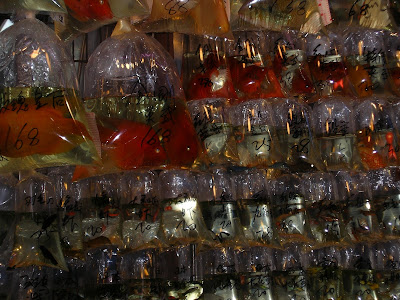













 Leather goldfish
Leather goldfishOut of a tank of about 80 goldfish, I managed to find 8 more leather goldfish and 2 more mirrorscale (linear) goldfish on Saturday 25 July 2009.
This batch has a lot of the finless leather goldfish (except the tail), and very similar to the one I once kept more than 15 years ago. However, these 'finless' leathers are still more steady in their swimming abilities than the one I had. They are also healthy despite their deformities.
Furthermore, in this batch of leathers, the pectoral fins are more often reduced to stubs, instead of small deformed pectoral fins like the other 2 leathers I had (this includes the fully dorsaled leather fish, which is the fish in the right of the top photo which shows them still in the bag. The middle photo in the bag shows the leather with one dorsal rib, and an orange/brown one underneath. That is the most coloured one out of this batch of leathers. The ones I saw and the one I had in the early 1990s were fully depigmented.
The 'bottom up' photos show the stubs when compared to the linear goldfish, ie, missing ventral and pectoral fins. They also show they are not blue bellies (ie, mock metallics or pseudo matts), but are just metallic goldfish if they had scales.
In brief, (See my March blog for further genetic details of leather goldfish), the leather goldfish is a further scale variation from the mirrorscales. Unlike mirrorscale, which shows a single variation in the s gene (which determines the location of the scale), leather goldfish requires variation in 2 genes in combination, the s and n gene (n= nude, no scale). Otherwise no leather goldfish can result, thus explaining their rarity. Apart from the fact that farmers may discard them as they are often deformed.
Their lack of finnage is the same as encountered in European carp c carpio, but in carp this is not as severe as what we have in goldfish (Kipichnikov (1937) investigated this in detail for c carpio). The lack of fins is due to biochemical inhibition, reducing effect on various organs (termed pleiotropic effects from the scale gene mutation).
One of the leather is coloured orange brown (shown most clear in the bag photos), and another a tinge of yellowish/orange brown, the rest were generally wild bronze to olive green. Some are very stocky in built. I have now a total of 10 leather goldfish at the moment.
Two out of the ten leathers that I got have complete dorsal fins, the rest have one to two hard rays in the dorsal to others having no dorsals at all.
There are both males and females in this batch of eight leather goldfish.
I took about 50 photos and they are much clearer in quality this time round (some shown here).
The smallest fish out of the 10 goldfish I bought this time round is the smaller of the two mirrorscale goldfish, it is just under 1.5 inches.
The chance of me maintaining a line of leather goldfish is now more hopeful as now I have a good quantity of them and sufficient variation in genetic material to avoid too much inbreeding.
© 27 July 2009 Bill L





















































